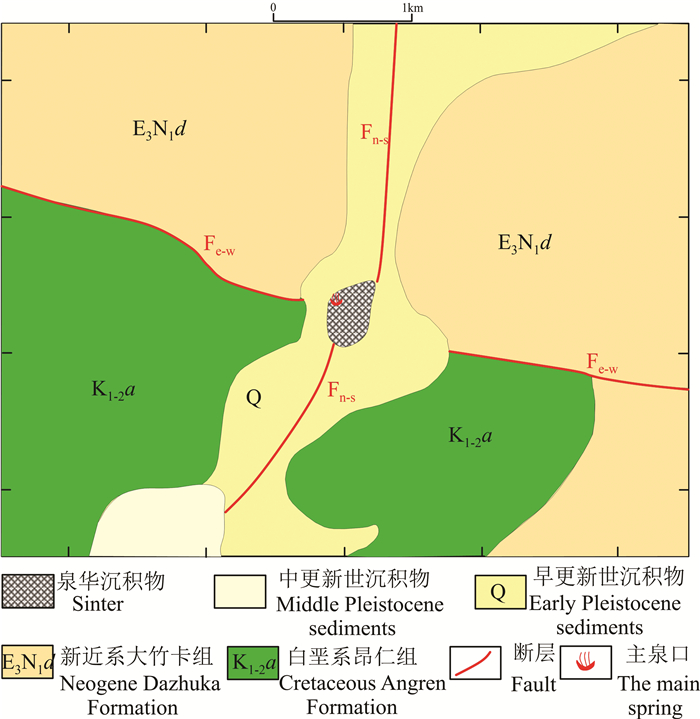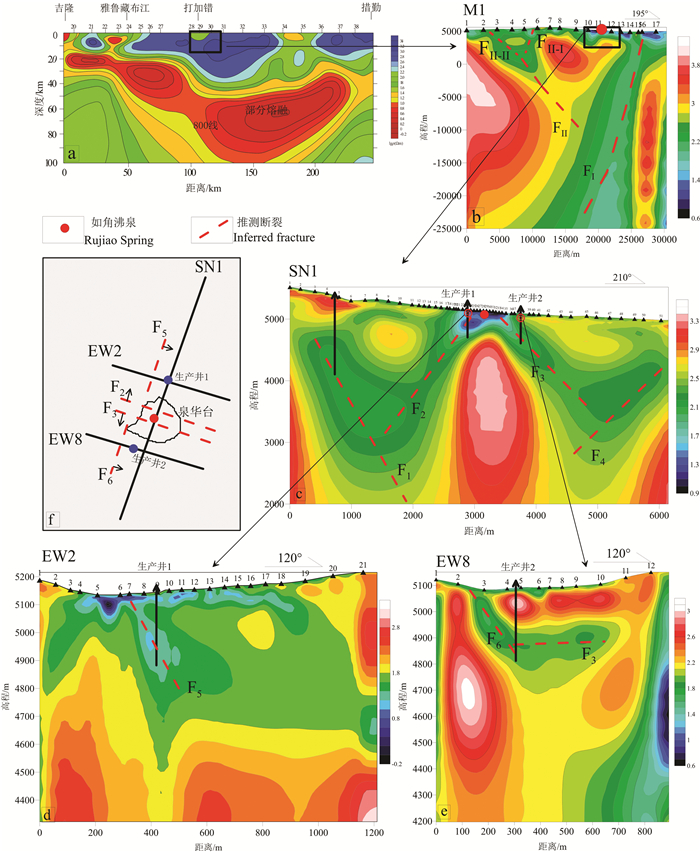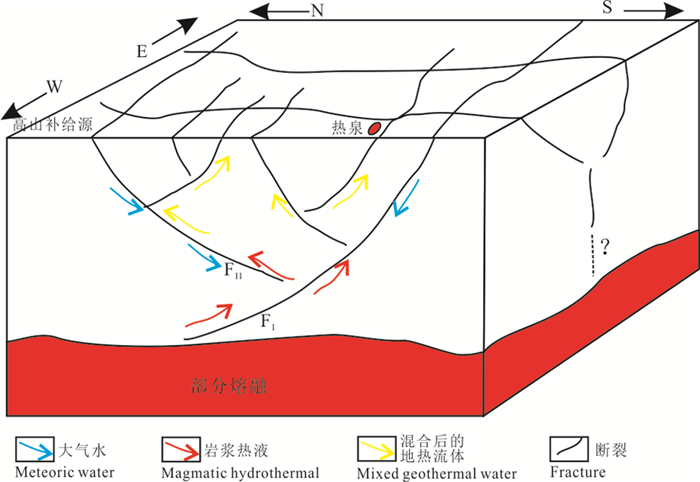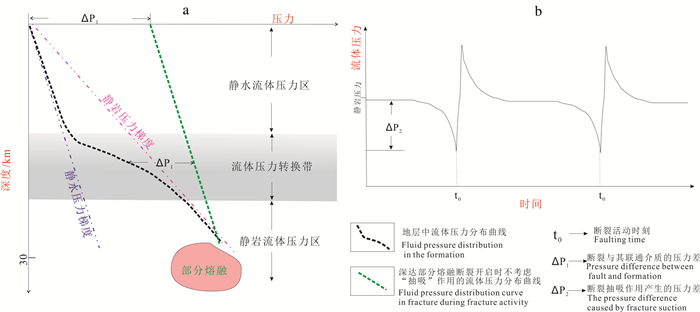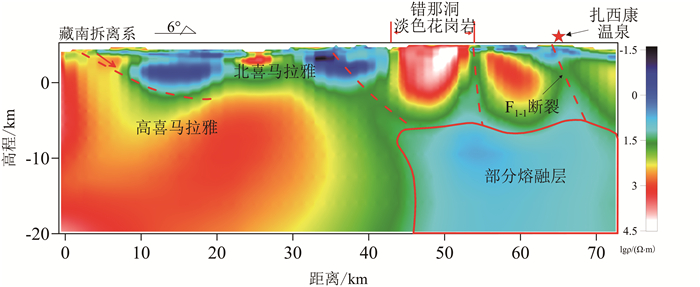Structure-thermal coupling model of the high temperature geothermal system in Rujiao on the Xizang Plateau
-
摘要:
研究目的 地表热异常的形成无外乎两方面原因:异常的热源及异常的热传递方式。“厚壳”与“热壳”共存,是青藏高原高温地热系统与一般汇聚板缘型地热系统的最大差异。部分熔融(热)作为“热壳”中的异常热源,断裂系统(构造)作为“厚壳”中的对流传热通道,清晰刻画两者空间关系,探讨构造-热耦合成热模式,可能是完善“厚壳”与“热壳”共存下青藏高原特色成热理论的重要途径。
研究方法 本次研究以萨嘎县如角沸泉为例,运用大地电磁测深、音频大地电磁测深。
研究结果 探测断裂系统与部分熔融的空间关系;结合已有地球物理、地热地球化学研究,建立如角沸泉构造-热耦合成热模式;并以断裂系统的交汇处为目标体,布设两口生产井。
结论 如角式构造-热耦合成热模式具有普适性,对于完善青藏高原特色成热理论及提高地热勘查成功率具有重要意义。
Abstract:This paper is the result of geothermal survey engineering.
Objective There are two reasons for the formation of surface thermal anomaly: abnormal heat source and abnormal heat transfer mode. The coexistence of "Thick Crust" and "Hot Crust" is the biggest difference between the high temperature geothermal system on the Xizang Plateau and the common convergent plate margin geothermal system.Partial melting (Hotsource) is an abnormal heat source in the "HotCrust", and fracture system (Structure) is a convective heat transfer channel in the "Thick Crust". Clearly depicting the spatial relationship between the two and exploring the structural-thermal coupling model of heat generation may be an important approach to improving the characteristic heat generation theory of the Xizang Plateau under the coexistence of a "Thick crust" and a "Hot crust".
Methods This study takes the Rujiao Boiling Spring in Saga County as an example, and uses magnetotelluric sounding and audio magnetotelluric sounding.
Results To explore the spatial relationship between the fault system and partial melting; we combined with previous studies on geophysics, geochemistry and fluid dynamics, established Rujiao boiling spring structure-thermal couplingthermal model; and set up two production wells with the intersection of the fault system as the target.
Conclusion The Rujiao tectonic-thermal coupled model of heat generation has universal applicability, which is of great significance for improving the formation theory of characteristic heat in the Xizang Plateau and enhancing the success rate of geothermal exploration.
-

-
图 6 穿过扎西康温泉的南北向大地电磁测深剖面(据Guo et al., 2019修改)
Figure 6.
-
Aggarwal J K, Sheppard D, Mezger K, Pernicka E. 2003. Precise and accurate determination of boron isotope ratios by multiple collector ICP-MS: Origin of boron in the Ngawha geothermal system, New Zealand[J]. Chemical Geology, 199: 331-342. doi: 10.1016/S0009-2541(03)00127-X
Bai Jiaqi, Mei Lin, Yang Meiling. 2006. Geothemal resources and crustal thermal strcture of the Qinghai-Xizang Plateau[J]. Journal of Geomechanics, 12(3): 354-362(in Chinese with English abstract).
Beaumont C, Jamieson R A, Nguyen M H, Lee B. 2001. Himalayan tectonics explained by extrusion of a low-viscosity crustal channel couled to focused surface denudation[J]. Nature, 414: 738-742. doi: 10.1038/414738a
Beaumont C, Jamieson R A, Nguyen M H, Medvedev S. 2004. Crustal channel flows: 1. Numerical models with applications to the tectonics of the Himalayan- Xizang orogen[J]. Journal of Geophysical Research, 109: B06406.
Beck R A, Burbank D W, Sercombe W J, Riley G W, Barndt J K, Berry J R, Afzal J, Khan A M, Jurgen H, Metje J, Cheema A, Shafique N A, Lawrence R D, Khan M A. 1995. Stratigraphic evidence for an Early Collision betweenNorthwest India and Asia[J]. Nature, 373: 55-58. doi: 10.1038/373055a0
Bibby H M, Caldwell T G, Davey F J, Webb T H. 1995. Geophysical evidence on the structure of the Taupovolcanic zone and its hydrothermal circulation[J]. Journal of Volcanology and Geothermal Research, 68: 29-58. doi: 10.1016/0377-0273(95)00007-H
Blisniuk P M, Hacker B R, Glodny J, Ratschbacher L, Bi S, Wu Z, McWilliams M O, Calvert A. 2001. Normal faulting in central Xizangsince at least 13.5 Myrago[J]. Nature, 412(6847): 628-632. doi: 10.1038/35088045
Brown L D, Zhao W, Nelson K D, Hauck M, Alsdorf D, Ross A, Cogan M, Clark M, Liu X, Che J. 1996. Bright spots, structure, and magmatism in southern Xizang from INDEPTH seismic reflection profiling[J]. Science, 274: 1688-1690. doi: 10.1126/science.274.5293.1688
Chen Kezao, Yang Shaoxiu, Zheng Xiyu. 1981. The salt lakes on the Qinghai-Xizang Plateau[J]. Acta Geographica Sinica, 36: 13-21 (in Chinese with English abstract).
Constable S C, Parker R L, Constable C G. 1987. Occam'sinversion: A practical algorithm for generating smooth models from electromagnetic sounding data[J]. Geophysics, 52(3): 289-300. doi: 10.1190/1.1442303
Cox S F. 2005. Coupling between deformation, fluid pressures, and fluid flow in ore-producing hydrothermal systems at depth in the crust[J]. Economic Geology 100th Anniversary Volume: 39-75.
Curewitz D, Karson J A. 1997. Structural settings of hydrothermal outflow: Fracture permeability maintained by fault propagation and interaction[J]. Journal of Volcanology and Geothermal Research, 79(3): 149-168.
Dor Ji, Zeng Yi, Jiao Xingyi, Jiao Yong. 2007. Review and consideration of geothermal power generation in Xizang[J]. Development and Protection of Geothermal Resources in China, 36-39(in Chinese).
Egbert J, Samuel S, James F, Chambefort I, Axelsson G, Gutiérrez-Negrín L C, Regenspurg S, Ziegler M, Ayling B, Richter A, Zemedkun M T. 2021. Geological controls on geothermal resources for power generation[J]. Nature Reviews Earth & Environment, 2: 324-339.
Guo J, Li W, Jiao Y, Liang S. 2019. Tectonic ‒ thermal coupling metallogenic models of Tethys Himalaya Pb ‒ Zn ‒ Sb ‒ Au belt in post-collisional stage[J]. Geotectonics, 53(2): 260-270. doi: 10.1134/S0016852119020043
Guo Jing, Xia Shibin. 2022. Spatial Carrier of Geothermal System in Eastern Sichuan Fold ZoneInterconnected Fault System: Taking the geothermal well in Moujia Town, Guang'an, Sichuan as an example[J]. Sedimentary Geology and Tethyan Geology, 42(4): 642-652(in Chinese).
He Zhiliang, Feng Jianyun, Zhang Ying, Li Pengwei. 2017. A tentative discussion on an evaluation system of geothermal unit ranking and classification in China[J]. Earth Science Frontiers, 24(3): 168-179 (in Chinese with English abstract).
Hodges K V. 2000. Tectonics of the Himalaya and southern Xizang from two perspectives[J]. Geological Society of America Bulletin, 112: 324-350. doi: 10.1130/0016-7606(2000)112<324:TOTHAS>2.0.CO;2
Hou Zengqian, Mo Xuanxue, Yang Zhiming, Wang Anjian, Pan Guitang, Qu Xiaoming, Nie Fengjun. 2006. Metallogeneses in the collisional orogeny of the Qinghai-Xizang Plateau: Tectonic setting, tempo- spatial distribution and ore deposit types[J]. Geology in China, 33(2): 340-351(in Chinese with English abstract).
Jamieson R A, Beaumont C, Medvedev S, Nguyen M H. 2004. Crustal channel flows: 2. Numerical models with implications for metamorphism in the Himalayan- Xizang orogen[J]. Journal of Geophysical Research, 109: B06407.
Jamieson R A, Beaumont C, Nguyen M H, Grujic D. 2006. Provenance of the Greater Himalayan Sequence and associated rocks: Predictions of channel flow models[J]. Geological Society of London, Special Publications, 268(1): 165-182. doi: 10.1144/GSL.SP.2006.268.01.07
Lee J, Whitehouse M J. 2007. Onset of mid-crustal extensional flow in southern Xizang: Evidence from U/Pb zircon ages[J]. Geology, 35(1): 45-48. doi: 10.1130/G22842A.1
Li Zhenqing. 2002. Present Hydrothermal Activities During Collisional Orogenics of the Xizang Plateau[D]. Beijing: Chinese Academy of Geological Sciences, 1-89(in Chinese with English abstract).
Li Zhenqing, Hou Zengqian, Nie Fengjun, Meng Xiangjin. 2005. Characteristic and distribution of the Partial Melting Layers in the upper crust evidence from active hydrothermal fluid in the South Xizang[J]. Acta Geologica Sinica, 79(1): 68-77(in Chinese with English abstract). doi: 10.3321/j.issn:0001-5717.2005.01.008
Liang Wei. 2014. Metallogenesis of Au-Sb-Pb-Zn mineralization in Tethys Himalaya Belt, South Xizang, China[D]. Beijing: China University of Geosciences (Beijing), 1-151 (in Chinese with English abstract).
Liao Zhijie, Wu Fangzhi. 2010. The development of Xizang geothermal power and low-carbon energy has great prospects[J]. China Geothermal Energy - Achievements and Prospects, 74-83 (in Chinese).
Lin Wenjing, Liu Zhiming, Wang Wanling, Wang Guiling. 2013. The assessment of geothermal resources potential of China[J]. Geology in China, 40(1): 312-321(in Chinese with English abstract).
Liu Mingliang. 2018. Boron Geochemistry of the Geothermal Waters From Typical Hydrothermal Systems in Xizang[D]. Wuhan: China University of Geosciences, 1-109(in Chinese with English abstract).
Lü Yuangyuan, Xu Ronghua, Zhao Ping, Xie Liewen, Li He. 2008. Determination of boron isotope ratios in aqueous samples by multiple collector ICP-MS[J]. Geochimica, 37(1): 1-8(in Chinese with English abstract).
Lü Yuanyuan, Zhao Ping, Xu Ronghua, Xie Liewen. 2012. Geochemical study on boron isotopes in the Yangbajing geothermal field, Xizang[J]. Chinese Journal of Geology, 47(1): 251-264(in Chinese with English abstract).
Lü Yuangyuan, Zheng Mianping, Zhao Ping, Xu Ronghua. 2014. Geochemical processes and origin of boron isotopes in geothermal water in the Yunnan- Xizang geothermal lzone[J]. Science China: Earth Sciences, 44(9): 1968-1979(in Chinese with English abstract).
Makovsky Y, Klemperer S L. 1999. Measuring the seismic properties of Xizangan bright spots: Evidence for free aqueous fluids in the Xizanganmiddle crust[J]. Journal of Geophysical Research, 104: 10795-10825 doi: 10.1029/1998JB900074
Nelson K D, Zhao W, Brown L D, Kuo J, Che J, Liu X, Klemperer S L, Makovsky Y, Meissner R, Mechie J, Kind R, Wenzel F, Ni J, Nabelek J, Chen L, Tan H, Wei W, Jones A G, Booker J, Unsworth M, Kidd W S F, Hauck M, Alsdorf D, Ross A, Cogan M, Wu C, Sandvol E, Edwards M. 1996. Partially molten middle crust beneath southern Xizang: Synthesis of Project INDEPTH results[J]. Science, 274: 1684-1688. doi: 10.1126/science.274.5293.1684
Rodi W L, MacKie R L. 2001. Nonlinear conjugate gradients algorithm for 2-Dmagnetotelluric inversion[J]. Geophysics, 66(1): 174-187. doi: 10.1190/1.1444893
Searle M P, Khan M A, Fraser J E, Gough S J, Jan M Q. 1999. The tectonic evolution of the Kohistan-Karakoram collision belt along the Karakoram highway transect, North Pakistan[J]. Tectonics, 18(6): 929-949. doi: 10.1029/1999TC900042
Shen Xianjie, Zhang Wenren, Yang Shuzhen, Guan Ye, Jin Xu. 1990. Heat flow evidence for the differentiated crust- mantle thermal structures of the northern and southern terranes of the Qinghai-Xizang Plateau[J]. Bulletin of the Chinese Academy of Geological Sciences, 21: 203-214(in Chinese with English abstract).
Smith J T, Booker J R. 1991. Rapid inversion of two and three-dimensional magnetotelluric data[J]. Journal of Geophysical Research: Solid Earth, 96(B3): 3905-3922. doi: 10.1029/90JB02416
Spivack A J, Edmond J M. 1986. Determination of boron isotope ratios by thermal ionization mass spectrometry of the dicesium metaborate cation[J]. Analytical Chemistry, 58: 31-35 doi: 10.1021/ac00292a010
Tong W, Zhang J. 1981. Characteristics of geothermal activities in Xizang Plateau and their controlling influence on Plateau's tectonic model[C]//Gordon B. Geological and Ecological Studies of the Qinghai-Xizang Plateau. 841-846.
Tong Wei, Zhang Zhifei, Zhang Mingtao, Liao Zhijie, You Maozheng, Zhu Meixiang, Guo Guoying, Liu Shibin. 1978. The Himalayan geothermal belt[J]. Journal of Peking University, 76-89(in Chinese with English abstract).
Wang Jiaying. 1992. Problem about static correction in magnetotellurics[J]. Geological Science and Technology Information, 11(1): 69-76(in Chinese with English abstract).
Wang Siqi. 2017. Hydrogeochemical Processes and Genesis Machenism of High- temperature Geothermal System in Gudui, Xizang[D]. Beijing: China University of Geosciences (Beijing), 1-107 (in Chinese with English abstract).
Wang Shaoting, Chen Xinmin. 1999. Present status and development of geothermal power generation and geothermal resources in Xizang[J]. Electric Power, 32(10): 79-82(in Chinese with English abstract).
Wang Y, Guo C, Chen X, Jia L, Guo X, Chen R. 2021. Carbon peak and carbon neutrality in China: Goals, implementation path and prospects[J]. China Geology, 4(4): 720-746.
Wang Y, Gu H, Li D, Lyu M, Lu L, Zuo Y, Song R. 2021. Hydrochemical characteristics and genesis analysis of geothermalfluid in the Zhaxikang geothermal field in Cuona County, southern Xizang[J]. Environmental Earth Sciences, 80: 415. doi: 10.1007/s12665-021-09577-8
Wei W, Unsworth M, Jones A, Booker J, Tan H D, Nelson D, Chen L, Li S, Solon K, Bedrosian P, Jin S, Deng M, Ledo J, Kay D, Roberts B. 2001. Detection of widespread fluids in the Xizang crust by magnetotelluric studies[J]. Science, 292: 716-718. doi: 10.1126/science.1010580
Wei Wenbo, Jin Shen, Ye Gaofeng, Deng Ming, Jing Jianen, Unsworth M. 2009. Conductivity structure and rheological property of lithosphere in Southern Xizang inferred from super- broadband magmetotulleric sounding[J]. Science China- Earth Sciences, 39 (11): 1591-1606(in Chinese with English abstract).
Williams H, Turner S, Kelley S, Harris N. 2001. Age and composition of dikes in southern Xizang: New constraints on the timing of east-west extension and its relationship to postcollisional volcanism[J]. Geology, 29: 339-342.
Wu Lili, Ma Wenzhan, Tang Yuan. 1984. On the water- chemical properties and formative conditions of high- boron brine in Qinghai- Xizang Plateau[J]. Geographical Research, (3): 1-11(in Chinese with English abstract).
Xu Zhiqin, Yang Jingsui, Li Haibing, Zhang Jianxin, Zeng Lingsen, Jiang Mei. 2006. The Qinghai- Xizang Plateau and continental dynamics: A review on terrain tectonics, collisional orogenesis, and processes and mechanisms for the rise of the plateau[J]. Geology in China, 33(2): 221-238(in Chinese with English abstract).
Yin A, Kapp P A, Murphy M A, Manning C E, Harrison T M, Grove M, Ding L, Deng X, Wu C. 1999. Significant Late Neogene east-west extension in northern Xizang[J]. Geology, 27(9): 787-790. doi: 10.1130/0091-7613(1999)027<0787:SLNEWE>2.3.CO;2
Yu Shengsong, Tang Yuan. 1981. The hydrochemical characteristics of the saline lakes on the Qinghai-Xizang Palteau[J]. Oceanologiaet Limnologia Sinica, (6): 498-511(in Chinese with English abstract).
Yuan J F, Guo Q H, Wang Y X. 2014. Geochemical behaviors of boron and its isotopes in aqueous environmentof the Yangbajing and Yangyi geothermal fields, Xizang, China[J]. Journal of Geochemical Exploration, 140: 11-22. doi: 10.1016/j.gexplo.2014.01.006
Zeng L, Gao L, Xie K, Zeng L. 2011. Mid-Eocene high Sr/Y granites in the Northern Himalayan gneiss domes: Melting thickened lower continental crust[J]. Earth and Planet Science Letters, 303(3/4): 251-266.
Zhang Chaofeng, Shi Qianglin, Zhang Lingjuan. 2018. Discussion on the relationship between Cenozoic magmatic activityand geotherm in Xizang Plateau[J]. Geological Survey of China, 5(2): 18-24(in Chinese with English abstract).
Zhang Eryong, Wen Dongguang, Wang Guiling, Yan Weide, Wang Wenshi, Ye Chengming, Li Xufeng, Wang Huang, Tang Xianchun, Weng Wei, Li Kuan, Zhang Chongyuan, Liang Mingxing, Luo Hongbao, Hu Hanyue, Zhang Wei, Zhang Senqi, Jin Xianpeng, Wu Haidong, Zhang Linyou, Feng Qingda, Xie Jingyu, Wang Dan, He Yunchao, Wang Yuewei, Chen Zubin, Cheng Zhengpu, Luo Weifeng, Yang Yi, Zhang Hao, Zha Enlai, Gong Yulie, Yu Zheng, Jiang Changsheng, Zhang Shengsheng, Niu Xue, Zhang Hui, Hu Lisha, Zhu Guilin, Xu Wenhao, Niu Zhaoxuan, Li Yang. 2022. The first power generation test of hot dry rock resources exploration and production demonstration project in the Gonghe Basin, Qinghai Province, China[J]. China Geology, 5: 372-382. doi: 10.31035/cg2022038
Zhang Jinjiang, Wang Jiamin, Wang Xiaoxian, Zhang Bo. 2013. A new model for the Himalayan orogeny[J]. Chinese Journal of Geology, 48(2): 362-383(in Chinese with English abstract).
Zhao Ping, Xie Ejun, Dor Ji, Jin Jian, Hu Xiancai, Du Shaoping, Yao Zhonghua. 2002. Geochemical characteristics of geothermal gases and their geological implications in Xizang[J]. Acta Petrologica Sinica, 18(4): 539-550(in Chinese with English abstract).
Zhao Wenjin, INDEPTH Project Team. 2001. Study on the Deep Structure and Structure of Himalayas and the Yarlung Zangbo River Suture Zone[M]. Beijing: Geological Publishing House (in Chinese).
Zhao Z, Li C, Ma X. 2021. How does the elevation changing response to crustal thickening process in the central Xizangan Plateau since 120 Ma?[J]. China Geology, 4(1): 32-43. doi: 10.31035/cg2021013
Zheng Mianping, Liu Wengao, Xiang Jun, Jiang Zhongti. 1983. On saline lakes in Xizang, China[J]. Acta Geologica Sinica, (2): 184-194(in Chinese with English abstract).
白嘉启, 梅琳, 杨美玲. 2006. 青藏高原地热资源与地壳热结构[J]. 地质力学学报, 12(3): 354-362.
陈克造, 杨绍修, 郑喜玉. 1981. 青藏高原的盐湖[J]. 地理学报, 36(1): 13-21
多吉, 曾毅, 焦兴义, 焦勇. 2007. 西藏地热发电的回顾与思考[J]. 中国地热资源开发与保护, 36-39.
郭镜, 夏时斌. 2022. 川东褶皱带地热系统的空间载体——相互连通的断裂系统: 以四川广安牟家镇地热井为例[J]. 沉积与特提斯地质, 42(4): 642-652.
何治亮, 冯建赟, 张英, 李朋威, 2017. 试论中国地热单元分级分类评价体系[J]. 地学前缘, 24(3): 168-179.
候增谦, 莫宣学, 杨志明, 王安建, 潘桂堂, 曲晓明, 聂凤军. 2006. 青藏高原碰撞造山带成矿作用: 构造背景、时空分布和主要类型[J]. 中国地质, 33(2): 340-351. http://geochina.cgs.gov.cn/cn/article/id/20060213
李振清. 2002. 青藏高原碰撞造山过程中的现代热水活动[D]. 北京: 中国地质科学院, 1-89.
李振清, 候增谦, 聂凤军, 孟祥金. 2005. 藏南上地壳低速高导层的性质与分布: 来自热水流体活动的证据[J]. 地质学报, 79(1): 68-77.
梁维. 2014. 特提斯喜马拉雅金锑铅锌成矿带成矿作用研究[D]. 北京: 中国地质大学(北京), 1-151.
廖志杰, 吴方之. 2010. 发展西藏地热电力低碳能源大有可为[J]. 中国地热能: 成就与展望, 74-83.
蔺文静, 刘志明, 王婉玲, 王贵玲. 2013. 中国地热资源及其潜力评估[J]. 中国地质, 40(1): 312-321. http://geochina.cgs.gov.cn/cn/article/id/20130121
刘明亮. 2018. 西藏典型高温水热系统中硼的地球化学研究[D]. 武汉: 中国地质大学, 1-109.
吕苑苑, 许荣华, 赵平, 谢列文, 李禾. 2008. 利用MC-ICP-MS对水样中硼同位素比值的测定[J]. 地球化学, 37(1): 1-8.
吕苑苑, 赵平, 许荣华, 谢列文. 2012. 西藏羊八井地热田硼同位素地球化学特征初步研究[J]. 地质科学, 47(1): 251-264.
吕苑苑, 郑绵平, 赵平, 许荣华. 2014. 滇藏地热带地热水硼同位素地球化学过程及其物源示踪[J]. 中国科学: 地球科学, 44(9): 1968-1979.
沈显杰, 张文仁, 杨淑贞, 管烨, 金旭. 1990. 青藏高原南北地体壳幔热结构差异的大地热流证据[J]. 中国地质科学院院报, (2): 203-214.
佟伟, 张知非, 章铭陶, 廖志杰, 由懋正, 朱梅湘, 过国颖, 刘时彬. 1978. 喜马拉雅地热带[J]. 北京大学学报, (1): 76-89.
王家映. 1992. 关于大地电磁的静校正问题[J]. 地质科技情报, 11(1): 69-76.
王思琪. 2017. 西藏古堆高温地热系统水文地球化学过程与形成机理[D]. 北京: 中国地质大学(北京), 1-107.
王绍亭, 陈新民. 1999. 西藏地热资源及地热发电的现状与发展[J]. 中国电力, 32(10): 79-82.
魏文博, 金胜, 叶高峰, 邓明, 景建恩, Unsworth M. 2009. 藏南岩石圈导电性结构与流变性-超宽频带大地电磁测深研究结果[J]. 中国科学(D辑), 39(11): 1591-1606.
吴俐俐, 马文展, 唐渊. 1984. 青藏高原高硼卤水的水化学特征及其成因[J]. 地理研究, (4): 1-11.
许志琴, 杨经绥, 李海兵, 张建新, 曾令森, 姜枚. 2006. 青藏高原与大陆动力学——地体拼合、碰撞造山及高原隆升的深部驱动力[J]. 中国地质, 33(2): 221-238. http://geochina.cgs.gov.cn/cn/article/id/20160101
于昇松, 唐渊. 1981. 青藏高原盐湖的水化学特征[J]. 海洋与湖沼, (6): 498-511.
张朝锋, 史强林, 张玲娟. 2018. 青藏高原新生代岩浆活动与地热关系探讨[J]. 中国地质调查, 5(2): 18-24.
张进江, 王佳敏, 王晓先, 张波. 2013. 喜马拉雅造山带造山模式探讨[J]. 地质科学, 48(2): 362-383.
赵平, 谢鄂军, 多吉, 金建, 胡先才, 杜少平, 姚中华. 2002. 西藏地热气体的地球化学特征及其地质意义[J]. 岩石学报, 18(4): 539-550.
赵文津, INDEPTH项目组. 2001. 喜马拉雅山及雅鲁藏布江缝合带深部结构与构造研究[M]. 北京: 地质出版社.
郑绵平, 刘文高, 向军, 蒋忠惕. 1983. 论西藏的盐湖[J]. 地质学报, (2): 184-194.
-



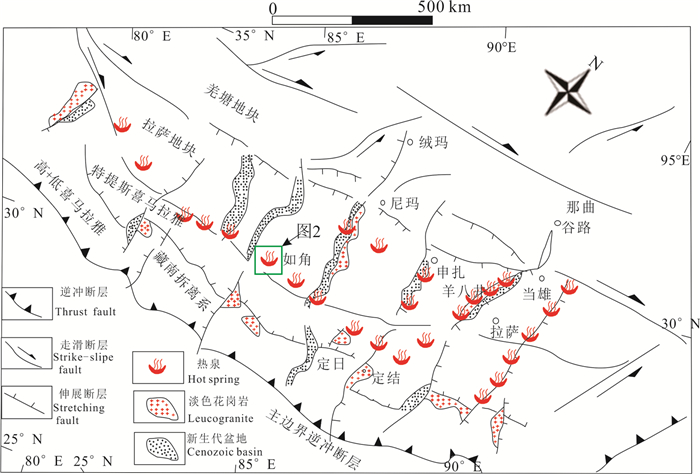
 下载:
下载:
